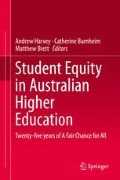Abstract
A Fair Chance for All and the related equity performance indicator framework have proven to be remarkably durable in framing equity policy for Australian higher education. This chapter anchors the retrospective and forward looking policy analysis included within this book to the context from which A Fair Chance for All and the equity performance indicators emerged. The Framework is a product of its time, and this first-hand account highlights that tensions and trade-offs evident in the policy design and implementation process are as relevant today as they were in 1990. In addition to a description of key events and stakeholders in the policy design and implementation process there are deeper insights that can be drawn from the durability of the Framework. Despite persistent inequality for most equity groups shown by the performance indicators since their introduction, the A Fair Chance for All framework has been successful in being able to quantify the degree of this inequality and highlighting the need for ongoing policy interventions. The longevity of the Framework can be attributed to a policy that was: suitably simple and accessible; practical and cost effective to implement; efficient in its use of indicators to allow for coherent analysis; and, catalytic in mobilising the efforts of institutions and individuals.
Access this chapter
Tax calculation will be finalised at checkout
Purchases are for personal use only
References
Anderson, D., & Vervoon, A. (1983). Access to privilege: Patterns of participation in Australian post-secondary education. Canberra: ANU Press.
Bradley, D., Scales, W., Noonan, P., & Nugent, H. (2008). Review of Australian higher education. Canberra: Commonwealth of Australia.
Croucher, G., Marginson, S., Norton, A., & Wells, J. (Eds.). (2014). The Dawkins revolution 25 years on. Melbourne: Melbourne University Press.
Dawkins, J. (1987). Higher education: A policy discussion paper. Canberra: Australian Government Publishing Service.
Dawkins, J. (1988). Higher education: A policy statement. Canberra: Australian Government Publishing Service.
Department of Education, Employment and Training. (1990). A fair chance for all: National and institutional planning for equity in higher education. Canberra: Australian Government Publishing Service.
Gale, T., & McNamee, P. (1994). Just out of reach: Access to equity in Australian higher education. The Australian Universities Review, 37(2), 8–11.
Griffith, D. (1992). Quantifying access to services in remote and rural Australia. Paper presented at the Rural Education and Research Association Conference, Alice Springs.
Jones, R. (1993). Socio-economic status of higher education students – Stage 1 report : Assessment of the postcode methodology (Vol. Report submitted to DEET from Evaluations and Investigations Project). Canberra.
Linke, R., Oertel (Martin), L., & Kelsey, N. (1985). Participation and equity in higher education: A preliminary report on the socio-economic profile of higher education students in South Australia, 1974-1984. Australian Bulletin of Labour, 11(3), 124–141.
Linke, R., with Oertel (Martin), L., & Kelsey, N. (1988). Regional analysis of socio-economic trends in educational participation (Vol. Departmental Monograph no. 7): Research School of Social Sciences, The Australian National University.
Linke R., et al. (1991). Performance Indicators in Higher Education – Report of a trial evaluation study commissioned by the Commonwealth Department of Employment, Education and Training. Canberra.
Martin, L. (1994). Equity and general performance indicators in higher education (Vol. 1). Canberra: Australian Government Publishing Service.
Author information
Authors and Affiliations
Corresponding author
Editor information
Editors and Affiliations
Rights and permissions
Copyright information
© 2016 Springer Science+Business Media Singapore
About this chapter
Cite this chapter
Martin, L. (2016). Framing the Framework: The Origins of A Fair Chance for All . In: Harvey, A., Burnheim, C., Brett, M. (eds) Student Equity in Australian Higher Education. Springer, Singapore. https://doi.org/10.1007/978-981-10-0315-8_2
Download citation
DOI: https://doi.org/10.1007/978-981-10-0315-8_2
Published:
Publisher Name: Springer, Singapore
Print ISBN: 978-981-10-0313-4
Online ISBN: 978-981-10-0315-8
eBook Packages: EducationEducation (R0)

